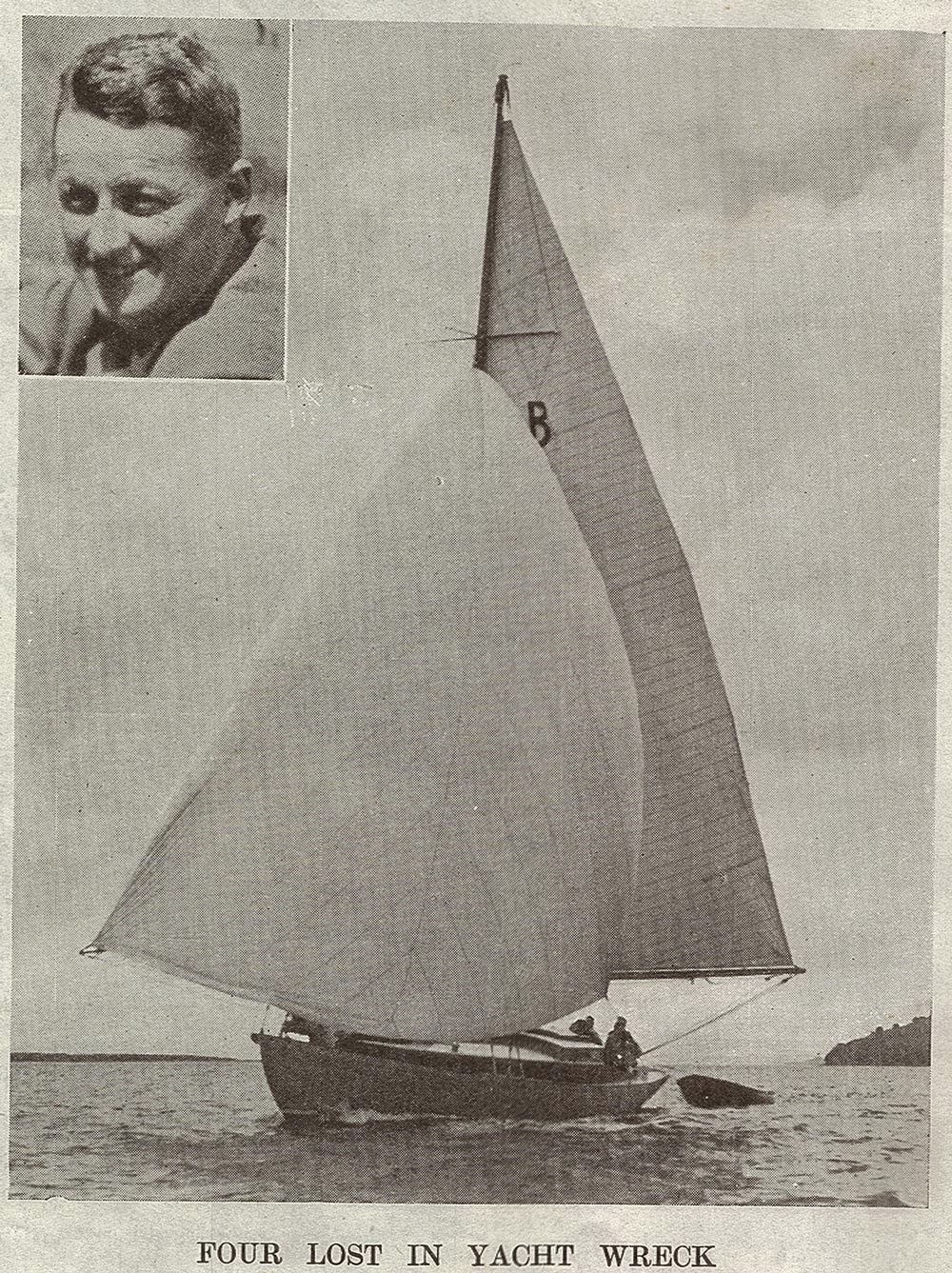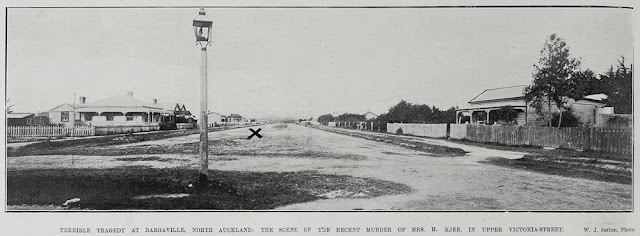The wreck of the yacht Ngahuia (1940)
Sir George Grey Special Collections, Auckland Libraries, AWNS-19400117-46-4
The B class keeler Ngahuia was launched from the Auckland yards of Lidgard & Sons in 1939, for Tauranga based garage proprieter Frank Gresham. Gresham sailed her to Tauranga to complete her interior. In December 1939, Ngahuia participated in the Auckland to Tauranga race coming in second to the yacht Ngahau. She was 38ft long, with a beam of 10ft 3in, and a draught of 5ft 6in.
The B class keeler Ngahuia was launched from the Auckland yards of Lidgard & Sons in 1939, for Tauranga based garage proprieter Frank Gresham. Gresham sailed her to Tauranga to complete her interior. In December 1939, Ngahuia participated in the Auckland to Tauranga race coming in second to the yacht Ngahau. She was 38ft long, with a beam of 10ft 3in, and a draught of 5ft 6in.
In the race to Tauranga the starters were Ranger, Restless, Ngahau and Ngahuia, a Tauranga yacht of a very handy size and good lines, which made a strong bid for the cup and at one part of the journey looked like winning it. Off Karewha Island she carried away her spinnaker boom. The veteran, Ngahau, 50 years old this month, made a great race of it against Messrs. Tercel brothers' hanger, built only 50 weeks ago, and from the seven-hour mark Ngahau won with just 45s to spare from Ngahuia.
Auckland Star, Volume LXX, Issue 308, 30 December 1939, Page 11
On January 12, Gresham and four others sailed from Tauranga to White Island in the Bay of Plenty the journey there and back to Tauranga had been without any incident. On the 13th they had again left Tauranga for White Island in what had been good sailing weather. On the return journey she hit rough weather. On the evening of January 13, Ngahuia ran into a storm with heavy seas. Gresham decided to try to head for Motiti Island to find shelter. The winds however had reached gale force, which prevented the vessel from reaching the island. An attempt was then made to go on to Mt Maunganui, but the force of the gale continued to frustrate any efforts to reach that location. The men on board Ngahuia had also tried to spot the seaward beacon on the Mount, but failed to do so and headed back out to sea once more in a fierce rain storm.
At 3 a.m., on the morning of January 14, Ngahuia ran aground on the shore of Matakana Island, 2 miles north of Mount Maunganui. Gresham the only survivor out of a crew of five had stated that 50 yards of boiling surf had lain between the crew and the safety of the nearby shoreline. Gresham had handed the four other members of his crew kapok mattresses, to use as floats after abandoning the vessel in the breakers.
Gresham had managed to swim to shore and then alert a nearby local resident who had sent for help. Search parties were sent out to find the four missing crew, but only the kapok mattresses they had used to keep afloat in the water were later found washed up on the beach.
It is feared that four men lost their lives when the B class keel yacht Ngahuia was wrecked on Matakana Island during a storm last night. The missing men are:— Mr. Leslie M. Mellars, married, aged 38, recently of Auckland and now local inspector at Tauranga for the National Insurance Company. Mr. Phillip H. Nielson, married, aged 33, borough council employee, of 11th Avenue, Tauranga. Mr. Roy Tonkin, single, aged 23, second son of Mr. C. Tonkin, builder and contractor, of Grey Street, Tauranga. Mr. John Herbert Willcock, aged 19, only son of Mr. S. G. Willcock, secretary of the Bay of Plenty Racing Club. The owner of the yacht, Mr. Frank C. Gresham, of Tauranga succeeded in reaching the shore and, although injured, struggled to Mr. R. Faulkner's homestead for help.
Auckland Star, Volume LXXI, Issue 12, 15 January 1940, Page 6
150 men were engaged in the search for the bodies of the four missing men. Matakana Island was thoroughly searched, but the crew were not found. Wreckage from the Ngahuia had started to come ashore; half of the vessel being found 8 miles north of where she had wrecked, with no sign of the bodies the searchers had hoped to find. On January 21, 1940 the bodies of two of the crew members Leslie M. Mellars and Roy Tonkin were found on the shore of Matakana Island. On January 26, the body of John Herbert Willcock was also found on the beach. The body of Philip Herbert Neilson was never recovered.
At the subsequent enquiry Gresham gave a detailed account of the events leading up to the tragic loss of four lives:
Frank Gordon Gresham, owner of the Ngahuia, slated that on their return trip from White Island they encountered bad weather, with poor visibility. About 11.30 p.m. he called Willcock on deck and they endeavoured to see the outline of the Mount or the North Rock light, but were unsuccessful. The boat, was handling splendidly, with no green water coming aboard.
At two o'clock they lowered, anchor with a 30 fathoms warp as a precaution. At 3.15 a.m. the yacht was knocked down by three successive curlers, but no damage was done. The next broke the mast. The hatches were torn off, the dinghy washed away and a hole made in the cabin top. The yacht evidently hit bottom.
Left, on Mattresses. The crew decided to leave the boat on kapok mattresses. Tonkin was first away, then Willcock. The remaining three stayed aboard until the yacht sank, then left the yacht together. Witness lost his mattress but managed to make shore after about half an hour. He noticed that all the mattresses were ashore and thought the crew safe. The Ngahuia was a triple-skinned yacht, perfectly seaworthy. Trouble started when they were unable to see the North Light. Had the light been half-way up the Mount to give a landfall, they would have been in no trouble. All the crew were yachts men and could swim.
Bay of Plenty Beacon, Volume 2, Issue 120, 7 February 1940, Page 5
In his conclusions the Coroner had noted that the "question of the light at the Mount would receive publicity. He would not add a rider, but would attach a note to the depositions suggesting that the Minister of Justice direct the attention of the Minister of Marine to the position of the light." (Bay of Plenty Beacon 7 February 1940)
Sources:
Auckland Star, Volume LXX, Issue 308, 30 December 1939, Page 11
Auckland Star, Volume LXXI, Issue 12, 15 January 1940, Page 6
Auckland Star, Volume LXXI, Issue 16, 19 January 1940, Page
5
Auckland Star , Issue 18, 22 January 1940, Page 3
Auckland Star, Volume LXXI, Issue 29, 3 February 1940, Page 11
Bay of Plenty Beacon, Volume 2, Issue 120, 7 February 1940, Page 5
Evening Post, Volume CXXIX, Issue 12, 15 January 1940, Page 9
Evening Post, Volume CXXIX, Issue 18, 22 January 1940, Page 3
Evening Post, Volume CXXIX, Issue 29, 3 February 1940, Page 8



Comments